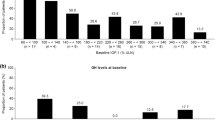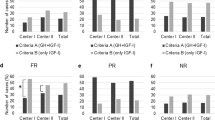Abstract
Purpose
Predicting the therapeutic effects of first-generation somatostatin receptor ligands (fg-SRLs) is important when assessing or planning effective treatment strategies in patients with acromegaly. The oft-used maximum growth hormone (GH) suppression rate parameter of the octreotide test has a suboptimal predictive value. Therefore, this study explored newer parameters of the octreotide test for predicting the therapeutic effect of long-acting fg-SRLs.
Methods
In this single-center retrospective study, the octreotide test parameters and the therapeutic effects of fg-SRL at 3 months were investigated in 45 consecutive treatment-naïve patients with acromegaly between April 2008 and March 2023. Additionally, the relationship between the octreotide test parameters and the therapeutic effects of fg-SRLs was investigated. Tumor shrinkage was evaluated based on changes in the longitudinal diameter of the macroadenomas. The area GH suppression rate-time under the curve (AUC) and the time to nadir GH level were calculated and compared with the maximum GH suppression rate.
Results
The AUC estimated reductions in serum insulin-like growth factor I, and tumor shrinkage. The time to nadir GH level predicted tumor shrinkage more robustly than the maximum GH suppression rate in patients with macroadenoma.
Conclusion
The AUC and time to nadir GH level may potentially be newer parameters of the octreotide test for estimating the therapeutic effect of fg-SRLs.





Similar content being viewed by others
Data and/or code availability
All relevant data are presented in the manuscript.
References
Fleseriu M, Langlois F, Lim DST et al (2022) Acromegaly: pathogenesis, diagnosis, and management. Lancet Diabetes Endocrinol 10:804–826. https://doi.org/10.1016/S2213-8587(22)00244-3
Giustina A, Barkan A, Beckers A et al (2020) A consensus on the diagnosis and treatment of acromegaly comorbidities: an update. J Clin Endocrinol Metab 105:e937–e946. https://doi.org/10.1210/clinem/dgz096
Melmed S, Bronstein MD, Chanson P et al (2018) A consensus statement on acromegaly therapeutic outcomes. Nat Rev Endocrinol 14:552–561. https://doi.org/10.1038/s41574-018-0058-5
Cuevas-Ramos D, Carmichael JD, Cooper O et al (2015) A structural and functional acromegaly classification. J Clin Endocrinol Metab 100:122–131. https://doi.org/10.1210/jc.2014-2468
Carmichael JD, Bonert VS, Nuño M et al (2014) Acromegaly clinical trial methodology impact on reported biochemical efficacy rates of somatostatin receptor ligand treatments: a meta-analysis. J Clin Endocrinol Metab 99:1825–1833. https://doi.org/10.1210/jc.2013-3757
Gadelha MR, Kasuki L, Korbonits M (2013) Novel pathway for somatostatin analogs in patients with acromegaly. Trends Endocrinol Metab 24:238–246. https://doi.org/10.1016/j.tem.2012.11.007
Fleseriu M, Biller BMK, Freda PU et al (2021) A Pituitary Society update to acromegaly management guidelines. Pituitary 24:1–13. https://doi.org/10.1007/s11102-020-01091-7
Ilie M-D, Tabarin A, Vasiljevic A et al (2022) Predictive factors of somatostatin receptor ligand response in acromegaly—a prospective study. J Clin Endocrinol Metab 107:2982–2991. https://doi.org/10.1210/clinem/dgac512
Lamberts SW, Uitterlinden P, Schuijff PC, Klijn JG (1988) Therapy of acromegaly with sandostatin: the predictive value of an acute test, the value of serum somatomedin-C measurements in dose adjustment and the definition of a biochemical “cure.” Clin Endocrinol 29:411–420. https://doi.org/10.1111/j.1365-2265.1988.tb02890.x
Puig Domingo M (2015) Treatment of acromegaly in the era of personalized and predictive medicine. Clin Endocrinol 83:3–14. https://doi.org/10.1111/cen.12731
Gadelha MR, Wildemberg LE, Kasuki L (2022) The future of somatostatin receptor ligands in acromegaly. J Clin Endocrinol Metab 107:297–308. https://doi.org/10.1210/clinem/dgab726
Gilbert JA, Miell JP, Chambers SM et al (2005) The nadir growth hormone after an octreotide test dose predicts the long-term efficacy of somatostatin analogue therapy in acromegaly. Clin Endocrinol 62:742–747. https://doi.org/10.1111/j.1365-2265.2005.02278.x
Halperin I, Nicolau J, Casamitjana R et al (2008) A short acute octreotide test for response prediction of long-term treatment with somatostatin analogues in acromegalic patients. Horm Metab Res 40:422–426. https://doi.org/10.1055/s-2008-1065339
Taboada GF, Donangelo I, Guimarães RFC et al (2005) Acute test with subcutaneous octreotide as a predictor of the response to treatment with octreotide LAR. Arq Bras Endocrinol Metabol 49:390–395. https://doi.org/10.1590/s0004-27302005000300010
de Herder WW, Taal HR, Uitterlinden P et al (2005) Limited predictive value of an acute test with subcutaneous octreotide for long-term IGF-I normalization with Sandostatin LAR in acromegaly. Eur J Endocrinol 153:67–71. https://doi.org/10.1530/eje.1.01935
Colao A, Pivonello R, Auriemma RS et al (2008) Growth hormone-secreting tumor shrinkage after 3 months of octreotide-long-acting release therapy predicts the response at 12 months. J Clin Endocrinol Metab 93:3436–3442. https://doi.org/10.1210/jc.2008-0424
Colao A, Auriemma RS, Lombardi G, Pivonello R (2011) Resistance to somatostatin analogs in acromegaly. Endocr Rev 32:247–271. https://doi.org/10.1210/er.2010-0002
Petersenn S, Houchard A, Sert C et al (2020) Predictive factors for responses to primary medical treatment with lanreotide autogel 120 mg in acromegaly: post hoc analyses from the PRIMARYS study. Pituitary 23:171–181. https://doi.org/10.1007/s11102-019-01020-3
Giustina A, di Filippo L, Uygur MM, Frara S (2023) Modern approach to resistant acromegaly. Endocrine 80:303–307. https://doi.org/10.1007/s12020-023-03317-7
Katznelson L, Laws ER Jr, Melmed S et al (2014) Acromegaly: an endocrine society clinical practice guideline. J Clin Endocrinol Metab 99:3933–3951. https://doi.org/10.1210/jc.2014-2700
Heck A, Ringstad G, Fougner SL et al (2012) Intensity of pituitary adenoma on T2-weighted magnetic resonance imaging predicts the response to octreotide treatment in newly diagnosed acromegaly. Clin Endocrinol 77:72–78. https://doi.org/10.1111/j.1365-2265.2011.04286.x
Hagiwara A, Inoue Y, Wakasa K et al (2003) Comparison of growth hormone-producing and non-growth hormone-producing pituitary adenomas: imaging characteristics and pathologic correlation. Radiology 228:533–538. https://doi.org/10.1148/radiol.2282020695
Isojima T, Shimatsu A, Yokoya S et al (2012) Standardized centile curves and reference intervals of serum insulin-like growth factor-I (IGF-I) levels in a normal Japanese population using the LMS method. Endocr J 59:771–780. https://doi.org/10.1507/endocrj.ej12-0110
Colao A, Ferone D, Lastoria S et al (1996) Prediction of efficacy of octreotide therapy in patients with acromegaly. J Clin Endocrinol Metab 81:2356–2362. https://doi.org/10.1210/jcem.81.6.8964877
Yamamoto M, Fukuoka H, Iguchi G et al (2015) The prevalence and associated factors of colorectal neoplasms in acromegaly: a single center based study. Pituitary 18:343–351. https://doi.org/10.1007/s11102-014-0580-y
Coopmans EC, Korevaar TIM, van Meyel SWF et al (2020) Multivariable prediction model for biochemical response to first-generation somatostatin receptor ligands in acromegaly. J Clin Endocrinol Metab 105:2964–2974. https://doi.org/10.1210/clinem/dgaa387
Giustina A, Mazziotti G, Torri V et al (2012) Meta-analysis on the effects of octreotide on tumor mass in acromegaly. PLoS ONE 7:e36411. https://doi.org/10.1371/journal.pone.0036411
Casar-Borota O, Heck A, Schulz S et al (2013) Expression of SSTR2a, but not of SSTRs 1, 3, or 5 in somatotroph adenomas assessed by monoclonal antibodies was reduced by octreotide and correlated with the acute and long-term effects of octreotide. J Clin Endocrinol Metab 98:E1730–E1739. https://doi.org/10.1210/jc.2013-2145
Wang M, Shen M, He W et al (2016) The value of an acute octreotide suppression test in predicting short-term efficacy of somatostatin analogues in acromegaly. Endocr J 63:819–834. https://doi.org/10.1507/endocrj.EJ16-0175
Karavitaki N, Botusan I, Radian S et al (2005) The value of an acute octreotide suppression test in predicting long-term responses to depot somatostatin analogues in patients with active acromegaly. Clin Endocrinol 62:282–288. https://doi.org/10.1111/j.1365-2265.2004.02191.x
Bianchi A, Valentini F, Iuorio R et al (2013) Long-term treatment of somatostatin analog-refractory growth hormone-secreting pituitary tumors with pegvisomant alone or combined with long-acting somatostatin analogs: a retrospective analysis of clinical practice and outcomes. J Exp Clin Cancer Res 32:40. https://doi.org/10.1186/1756-9966-32-40
Chiloiro S, Costa D, Lauretta R et al (2022) Partial response to first generation SSA guides the choice and predict the outcome of second line therapy in acromegaly. Endocrine 78:343–353. https://doi.org/10.1007/s12020-022-03158-w
Chiloiro S, Giampietro A, Mirra F et al (2021) Pegvisomant and pasireotide LAR as second line therapy in acromegaly: clinical effectiveness and predictors of response. Eur J Endocrinol 184:217–229. https://doi.org/10.1530/EJE-20-0767
Gadelha MR, Bronstein MD, Brue T et al (2014) Pasireotide versus continued treatment with octreotide or lanreotide in patients with inadequately controlled acromegaly (PAOLA): a randomised, phase 3 trial. Lancet Diabetes Endocrinol 2:875–884. https://doi.org/10.1016/S2213-8587(14)70169-X
Cozzi R, Attanasio R, Montini M et al (2003) Four-year treatment with octreotide-long-acting repeatable in 110 acromegalic patients: predictive value of short-term results? J Clin Endocrinol Metab 88:3090–3098. https://doi.org/10.1210/jc.2003-030110
Theodoropoulou M, Stalla GK (2013) Somatostatin receptors: from signaling to clinical practice. Front Neuroendocrinol 34:228–252. https://doi.org/10.1016/j.yfrne.2013.07.005
Carlsen SM, Lund-Johansen M, Schreiner T et al (2008) Preoperative octreotide treatment in newly diagnosed acromegalic patients with macroadenomas increases cure short-term postoperative rates: a prospective, randomized trial. J Clin Endocrinol Metab 93:2984–2990. https://doi.org/10.1210/jc.2008-0315
Fleseriu M, Hoffman AR, Katznelson L, Neuroendocrine AACE, Committee PS (2015) American association of clinical endocrinologists and American college of endocrinology disease state clinical review: management of acromegaly patients: what is the role of pre-operative medical therapy? Endocr Pract 21:668–673. https://doi.org/10.4158/EP14575.DSCR
Yang C, Li G, Jiang S et al (2019) Preoperative somatostatin analogues in patients with newly-diagnosed acromegaly: a systematic review and meta-analysis of comparative studies. Sci Rep 9:14070. https://doi.org/10.1038/s41598-019-50639-6
Albarel F, Cuny T, Graillon T et al (2022) Preoperative medical treatment for patients with acromegaly: yes or no? J Endocr Soc 6:bvac114. https://doi.org/10.1210/jendso/bvac114
Daly AF, Tichomirowa MA, Petrossians P et al (2010) Clinical characteristics and therapeutic responses in patients with germ-line AIP mutations and pituitary adenomas: an international collaborative study. J Clin Endocrinol Metab 95:E373–E383. https://doi.org/10.1210/jc.2009-2556
Chahal HS, Trivellin G, Leontiou CA et al (2012) Somatostatin analogs modulate AIP in somatotroph adenomas: the role of the ZAC1 pathway. J Clin Endocrinol Metab 97:E1411–E1420. https://doi.org/10.1210/jc.2012-1111
Peverelli E, Treppiedi D, Giardino E et al (2015) Dopamine and somatostatin analogues resistance of pituitary tumors: focus on cytoskeleton involvement. Front Endocrinol 6:187. https://doi.org/10.3389/fendo.2015.00187
Gatto F, Biermasz NR, Feelders RA et al (2016) Low beta-arrestin expression correlates with the responsiveness to long-term somatostatin analog treatment in acromegaly. Eur J Endocrinol 174:651–662. https://doi.org/10.1530/EJE-15-0391
Fougner SL, Lekva T, Borota OC et al (2010) The expression of E-cadherin in somatotroph pituitary adenomas is related to tumor size, invasiveness, and somatostatin analog response. J Clin Endocrinol Metab 95:2334–2342. https://doi.org/10.1210/jc.2009-2197
Henriques DG, Miranda RL, Dezonne RS et al (2023) miR-383-5p, miR-181a-5p, and miR-181b-5p as predictors of response to first-generation somatostatin receptor ligands in acromegaly. Int J Mol Sci 24:2875. https://doi.org/10.3390/ijms24032875
Acknowledgements
The authors are grateful to Ms. K. Imura, Ms. M. Kitamura, and Ms. M. Sakoda for their assistance. The authors did not receive support from any organization for the submitted work. We would like to thank Editage (http://www.editage.jp) for English language editing.
Funding
The authors did not receive support from any organization for the submitted work.
Author information
Authors and Affiliations
Contributions
SU, MY, and YT: Conceptualization; SU: Data curation and investigation; SU, MY, NY, MS, HS, KK, YF, HB, HF, MT, GI, YT, and WO: Resources and formal analysis; SU: Writing—original draft preparation and Visualization; MY and YT: Writing—review and editing; MY: Project administration and Supervision. All the authors contributed to the discussion and approved the final version of the manuscript.
Corresponding author
Ethics declarations
Competing interests
The authors have no competing interests to declare that are relevant to the content of this article.
Ethical approval
This study was conformed to the Declaration of Helsinki guideline and was approved by the ethics committee of Kobe University Graduate School of Medicine (Approval No. 1363).
Informed consent
Informed consent was obtained from the participants using an opt-out approach.
Additional information
Publisher's Note
Springer Nature remains neutral with regard to jurisdictional claims in published maps and institutional affiliations.
Rights and permissions
Springer Nature or its licensor (e.g. a society or other partner) holds exclusive rights to this article under a publishing agreement with the author(s) or other rightsholder(s); author self-archiving of the accepted manuscript version of this article is solely governed by the terms of such publishing agreement and applicable law.
About this article
Cite this article
Urai, S., Yamamoto, M., Yamamoto, N. et al. Newer parameters of the octreotide test in patients with acromegaly. Pituitary 27, 33–43 (2024). https://doi.org/10.1007/s11102-023-01362-z
Accepted:
Published:
Issue Date:
DOI: https://doi.org/10.1007/s11102-023-01362-z




